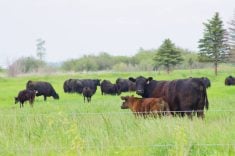An American bumper crop and Canadian drought combine to increase imports to three million tonnes with more expected
Feed corn is proving to be a lifeline to western Canadian ranchers.
Millions of tonnes are being imported into Canada from the United States following a bumper crop there, shoring up Canadian farmers’ low supplies. It is desperately needed following the 2021 prairie drought.
Endiang, Alta., rancher Stuart Somerville said the imported feed corn will help sustain his operation.
“The price of barley just kept climbing and hay and greenfeed became harder and harder to find, but being able to find corn at a competitive price means that we’ll be able to feed those cattle a little bit longer,” said Somerville.
Read Also

House ag committee to undertake several studies
The House of Commons standing agriculture committee has set its agenda for the coming months. Members began the fall sitting with a two-hour update on international trade
He is not alone judging by the amount of corn coming from the U.S.
U.S. Grains Council director of global programs Cary Sifferath said corn exports to Canada are outpacing initial estimates.
More than three million tonnes of U.S. corn had been sold to Canada by the end of December.
“The World Agriculture Supply and Demand Estimate (WASDE) that the USDA puts out every month, they actually right now have Canada importing three million tonnes but we already have more sales on the books and just short of one million tonnes that’s already been shipped,” said Sifferath.
On average, Canada imports 1.5 to two million tonnes of U.S. corn.
“I think we’ll easily see another probably two million tonnes sold and traded into Canada throughout the rest of the marketing year running through August,” said Sifferath.
That WASDE estimate is expected to be revised upward in the next monthly report, expected to be released in mid-January.
“We are definitely seeing increased interest and demand for U.S. corn out in Western Canada,” said Sifferath.
While there were weather challenges in parts of the U.S., Sifferath said 2021 will likely turn out to be the second-largest corn crop in their history.
“We definitely have the supplies,” he said.
Shipments by rail are also being adapted to move corn faster into Canada with the U.S. bumping up its train units to 142 cars from its usual standard of 110 cars from railyards in North Dakota, said Sifferath.
Dried distillers grain, a byproduct of ethanol production from corn feedstock, is also seeing an uptick of exports to Canada, added Sifferath.
Between January and November 2021, 652,000 tonnes of dried distillers grain were imported into Canada, way up from the 365,000 tonne average.
“Most of that is going into Western Canada as well,” he said.
For Somerville, the price for corn will be the make-or-break point for his operation.
“If we can keep buying corn at roughly the price that we are buying it at now, we will just squeak through,” he said. “The only way we can stretch out our supply of forage is just with some kind of grain and the price of barley is just too high.”
According to Lethbridge-based Market Place Commodities’ David Lea, corn is currently trading at between $415 and $420 per tonne with indications that price may move upward.
The price is significantly higher than the five-year average of $270 per tonne, he added.
Janice Tranberg, president of the Alberta Cattle Feeders Association, called the amounts of corn imports into Canada “unprecedented.”
“The feeders are looking to bring dried distillers grains and corn from the U.S. up as much as they can,” she said.
One of the biggest challenges is moving so much corn, she added.
“This isn’t a typical route to the degree we’re bringing it up. Normally, we’re worried about how are we getting our grain west,” said Tranberg.
While that’s not an issue this year, which has allowed resources and infrastructure to be directed toward moving corn, it’s unclear yet whether that will be enough to meet the needs of feeders.
“It’s not that there is a lack of supply. It’s more a constraint on transportation, on getting it here on a timely basis,” she said.
For Somerville, matching supply with need is also complicated by having to find the money to pay for the corn.
His operation has received one super-B grain trailer of corn and estimates seven more will be needed to get through to the spring.
“We would love to buy our whole supply but juggling cash makes it impossible to do so right now,” he said. “You have to juggle it between sales and all that.”
He said a friendly turn in the weather is what many people need most.
“We just have to pray the harder weather of winter ends as soon as possible and the rest of the stars align come spring so these cattle we carried through are worth something at the other end,” he said.


















